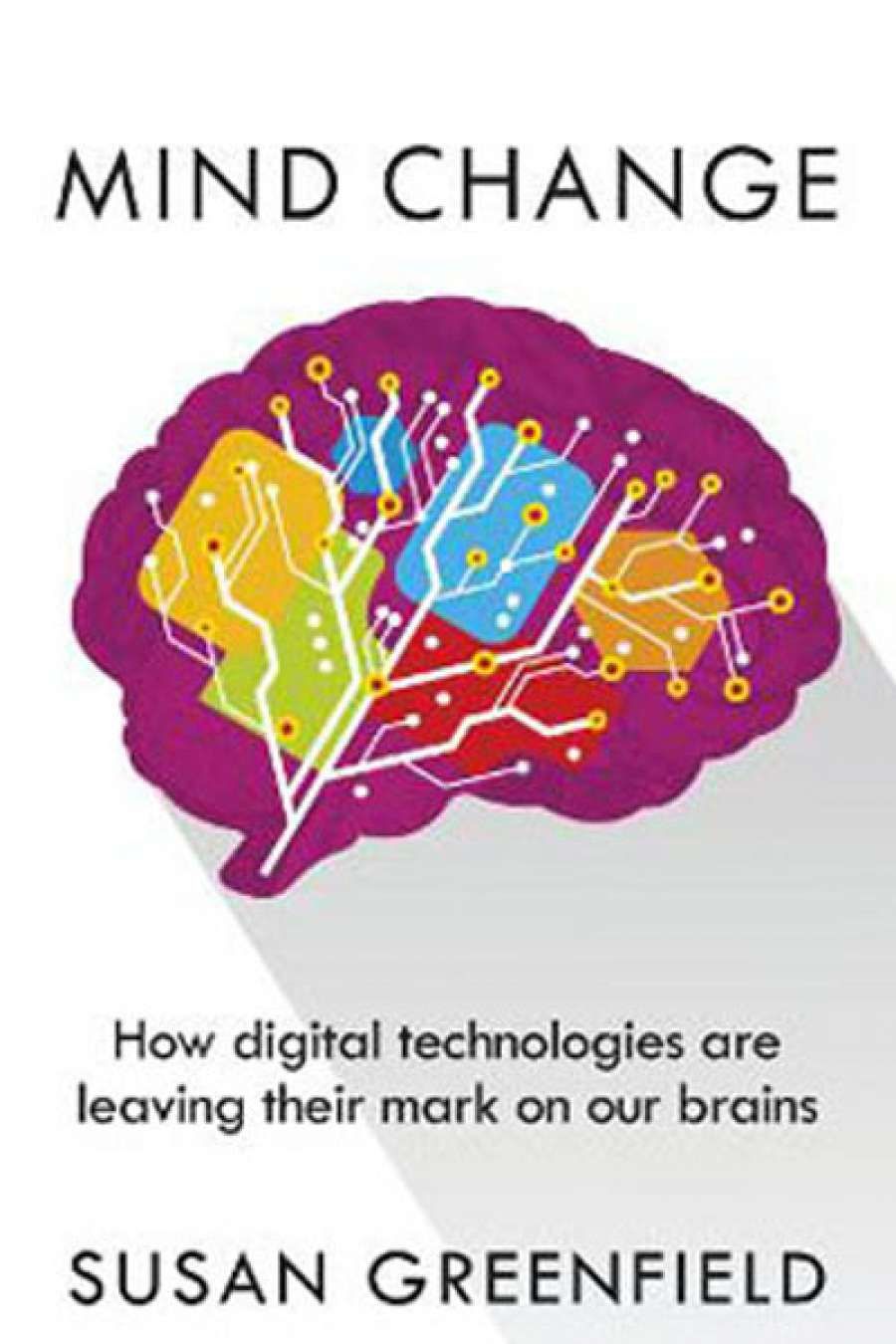
- Free Article: No
- Contents Category: Science and Technology
- Custom Article Title: Nick Haslam reviews 'Mind Change' by Susan Greenfield
- Review Article: Yes
- Article Title: Digital wildfire
- Online Only: No
- Custom Highlight Text:
Over at the academy, the lecture is not what it used to be. Colourful slides and short videos accompany the spoken word, and this audio-visual feast can be ordered take-away, lecture recordings instantly downloadable from the university’s ‘learning management system’. Students sit, laptops open, alternating their gaze between the lectern and the web. Many stay home, speeding up the recordings to whiz through the dull bits. Academics speculate on whose lectures will be chipmunked the most.
Most of these students are digital natives, a generation that has grown up with the Internet, Facebook, immersive video games, and mobile devices. According to Susan Greenfield, a prolific Oxford neuroscientist, the natives are restless. They are also narcissistic, superficial, passive, inattentive, uncentred, and aggressive. In Mind Change, Greenfield ties these failings together as a syndrome of our time. Its cause, she argues, is the steady encroachment of digital technologies into our lives. Greenfield has raised concerns about their influence for many years, and her book attempts to marshal the scientific evidence to support them.
- Book 1 Title: Mind Change
- Book 1 Subtitle: How digital technologies are leaving their mark on our brains
- Book 1 Biblio: Rider $35 pb, 384 pp
Mind Change begins by charting the remarkable global rise of digital technologies, where many more people now have access to mobile phones than to functioning toilets. These technologies are pervasive as well as prevalent, surveys showing that many of us are connected for most of our waking hours. Greenfield proceeds to review the neuroscience of brain plasticity. The mind, she writes, emerges from the brain through personalised patterns of neural connectivity borne of interaction with the surrounding environment. If individual brains change in response to experience, and much experience is now digitally mediated, it stands to reason, Greenfield argues, that our brains are undergoing a collective transformation. What will the brain of the future be like?
 Susan Greenfield
Susan Greenfield
The remainder of the book lays out a pessimistic answer to this question, backed by an assortment of psychology and neuroscience research. Social networking creates identities that are externally constructed and exhibitionistic, produces relationships that are shallow and envious, and provides a lawless frontier for bullies, trolls, and judgemental mobs. Video games corrode the capacity for sustained attention, diminish empathy, promote aggression, and addict people to a fast-paced sensory present that seems more real to them than the three-dimensional world off-screen. Search engines offer up disconnected facts, encouraging a style of learning that is superficial and unfocused. Knowledge is prosthetic and accessible wherever there is an Internet connection, so why bother committing it to memory?
Greenfield refers to this pattern of neural, psychological, and social developments as ‘mind change’, a pointed analogy to climate change. She maintains that digital technologies are creating runaway alterations in how people think, feel, and relate that we ignore at our peril. Left unchecked, the heat of ten billion screens will spark digital wildfires and swamp low-lying islands of human decency. Positioned as change deniers in this analogy, blind to an inconvenient truth, it is little wonder that Greenfield’s critics might object. The tone of much of the criticism of her work has indeed been sharp and personal.
At its root, Greenfield’s position is romantic and humanist. She values depth, understanding, the intimacy of face-to-face communication, and the integrity of the private self. In her telling, cyberculture threatens these values, replacing depth with breadth, slow-cooked social connection with the junk food of Facebook friends, and firmly anchored personal identity with outwardly focused self-display. Many humanist critics lament that technology denatures people, turning them into emotionless robots, but Greenfield argues instead that it turns them into children, uncivilised and dependent creatures of the moment. On her account, the pathologies of screen culture all share an excessive focus on the here and now, an excessive release of dopamine, a neurochemical implicated in pleasure, reward and addiction, and an underactive prefrontal cortex, the site of distinctively human capacities for forethought, planning and self-control. Embubbled in a virtual present, Greenfield’s gaming addicts, compulsive email checkers, and Internet surfers lack a sense of meaning, identity, and autonomy.
Mind Change certainly has its flaws. Greenfield is so keen to prosecute her case that her conclusions are often exaggerated and unbalanced. Although she acknowledges that digital technologies have some positive uses, the book often reads as a relentless jeremiad. Greenfield overreaches in linking the rising rate of autism to the spread of digital technology. Although she often recognises the difficulties of inferring cause and effect, caution sometimes takes leave and a technology is held responsible for a problem that may merely accompany it. Greenfield often picks a single digital strand from the tangled skein of factors – social, cultural, and economic – that might bear on such problems. The evidence for some of these, such as generational increases in narcissism, is flimsy. Crucially, Greenfield is not persuasive in arguing that the digital revolution is any more unprecedented than other social and technological transformations, many of which had their own prophets of doom.
However, it is too easy to dismiss Greenfield’s position as merely nostalgic, alarmist, and dystopian. Much of the academic commentary around digital technologies is one-sidedly utopian, celebrating their supposed democratisation of knowledge, elevation of global consciousness, and strengthening of social connections. Digital technologies do have a dark side that is a legitimate cause for concern, and a growing social scientific literature examines it. Greenfield’s synthesis of this literature in Mind Change is tendentious and incomplete, but it is just the first salvo in an extended, vital argument.


Comments powered by CComment